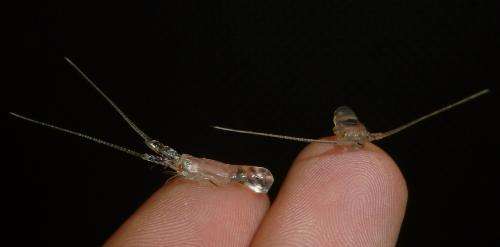'Tailing' spiny lobster larvae to protect them

The commercial value of spiny lobster (Panulirus argus) in the Caribbean reaches $1 billion annually, thus making it one of the most valuable fisheries in the region. In a new study of this iconic species, Ph.D. candidate Andrew Kough and Dr. Claire Paris of the Biophysical Interactions Lab at the University of Miami Rosenstiel School of Marine & Atmospheric Science, in collaboration with Dr. Mark Butler from Old Dominion University, studied the larval dispersal of this species in the Caribbean. The goal of the study was to describe the sources, sinks, and routes connecting the Caribbean spiny lobster metapopulation. The results led the team to propose marine resource management strategies that incorporate larval connectivity and "larval lobster credits" to sustain and rebuild exploited marine populations.
The study, which appears in the June 2013 issue of the journal PLOS ONE, synthesizes empirical data from laboratory studies, mail surveys and published works to parameterize an individual-based model of lobster larval connectivity, the Connectivity Modeling System (CMS), developed by Paris. Results were then verified using two independent studies, separated by over 500 km, giving validation to the model's performance—something never before achieved for spiny lobster or other pelagic larvae over such large scales.
"Spiny lobster have extraordinary larvae with a prolonged planktonic existence that can last from five months to nearly a year, which confer them with high dispersal potential and complex pelagic pathways. Despite such challenges in documenting their pathways in the open ocean, just like hurricane models that help to reduce the 'cone of uncertainty', in this case we are improving settlement predictions by simulating large numbers of spawning events and tracking virtual larvae undergoing deep vertical migrations," says Paris.
The prevailing Caribbean current may not be the best path for successful long distance transportation for larvae. Contrary to the established belief, the team's results suggest that powerful currents entrain and push larvae out of the system, acting like a "Highway to Hell." The larvae that ultimately settle in the simulation spend little time within these strong currents. By moving to deeper depths as they age, spiny lobster larvae seem to increase their odds of settlement.
Butler adds, "Despite some expected degree of ocean mixing in the region, we found relatively high levels of larvae settling back to their place of origin. This was surprising for larvae that spend up to 12 months traveling in the plankton. But even more surprising was that these simple larval behaviors added to the model also enhanced population connectivity by preventing larvae from being flushed out of the system."
Based on the dynamics of long distance larval exchange uncovered using this computational model, the team proposes potential strategies that may be used to better manage the Caribbean spiny lobster population, and increase the sustainability of this economically important fishery.
"We blended ideas from international trade, terrestrial conservation, and carbon emission protocols to suggest 'larval lobster credits' as a viable cooperative management strategy. Predicted larval flow around in the region is dependent on several source regions, which are optimally located for wide ranging dispersal. If the nations receiving the influx of larvae and harvesting the adult lobsters were to invest and help protect these source regions, we believe that the future of the fishery will be more secure and may even improve, which would benefit the entire region ecologically and economically," explains Kough.
More information: The paper, titled "Larval Connectivity and the International Management of Fisheries" by Kough, Paris, and Butler is available online at www.plosone.org/article/info%3Adoi%2F10.1371%2Fjournal.pone.0064970
Journal information: PLoS ONE
Provided by University of Miami



















